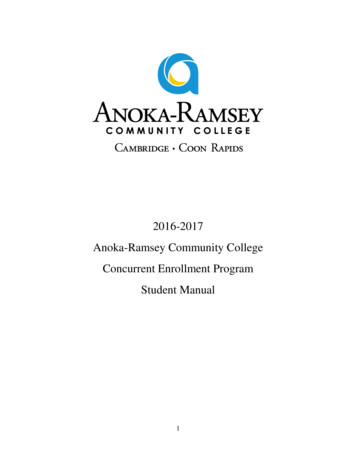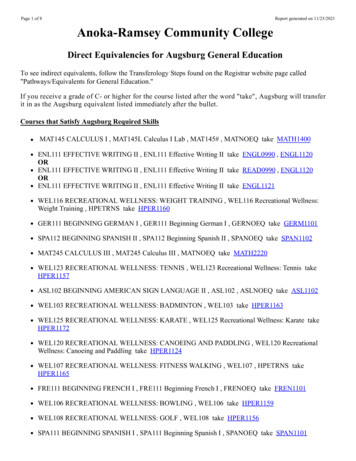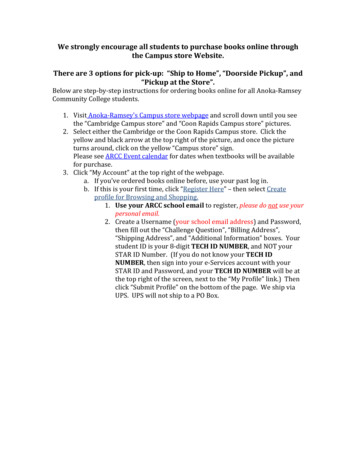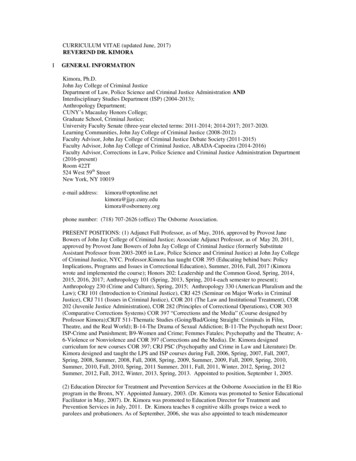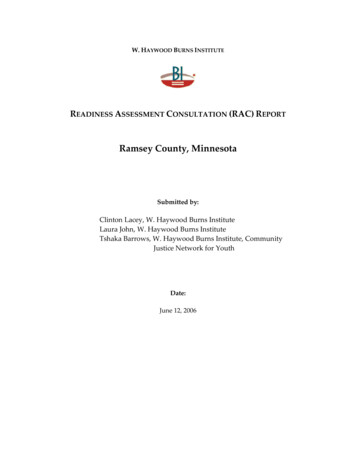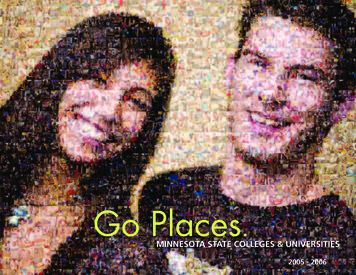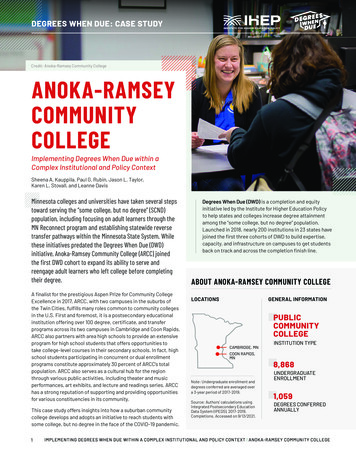
Transcription
DEGREES WHEN DUE: CASE STUDYCredit: Anoka-Ramsey Community CollegeANOKA-RAMSEYCOMMUNITYCOLLEGEImplementing Degrees When Due within aComplex Institutional and Policy ContextSheena A. Kauppila, Paul G. Rubin, Jason L. Taylor,“It’s JusttheandRightThingKarenL. Stovall,LeanneDavis to Do for Students:”Aiding the Community by Serving IndividualsMinnesotacollegesand universitieshave taken several stepswith SomeCollege,but No Degreetoward serving the “some college, but no degree” (SCND)Paul G. Rubin, Sheena A. Kauppila, Jason L. Taylor,population,includingfocusingon adult learners through theKaren L. Stovall,and LeanneDavisMN Reconnect program and establishing statewide reversetransfer pathways within the Minnesota State System. Whilethese initiatives predated the Degrees When Due (DWD)initiative, Anoka-Ramsey Community College (ARCC) joinedthe first DWD cohort to expand its ability to serve andreengage adult learners who left college before completingtheir degree.A finalist for the prestigious Aspen Prize for Community CollegeExcellence in 2017, ARCC, with two campuses in the suburbs ofthe Twin Cities, fulfills many roles common to community collegesin the U.S. First and foremost, it is a postsecondary educationalinstitution offering over 100 degree, certificate, and transferprograms across its two campuses in Cambridge and Coon Rapids.ARCC also partners with area high schools to provide an extensiveprogram for high school students that offers opportunities totake college-level courses in their secondary schools. In fact, highschool students participating in concurrent or dual enrollmentprograms constitute approximately 30 percent of ARCC’s totalpopulation. ARCC also serves as a cultural hub for the regionthrough various public activities, including theater and musicperformances, art exhibits, and lecture and readings series. ARCChas a strong reputation of supporting and providing opportunitiesfor various constituencies in its community.This case study offers insights into how a suburban communitycollege develops and adopts an initiative to reach students withsome college, but no degree in the face of the COVID-19 pandemic.1Degrees When Due (DWD) is a completion and equityinitiative led by the Institute for Higher Education Policyto help states and colleges increase degree attainmentamong the “some college, but no degree” population.Launched in 2018, nearly 200 institutions in 23 states havejoined the first three cohorts of DWD to build expertise,capacity, and infrastructure on campuses to get studentsback on track and across the completion finish line.ABOUT ANOKA-RAMSEY COMMUNITY COLLEGELOCATIONSGENERAL INFORMATIONPUBLICCOMMUNITYCOLLEGECAMBRIDGE, MNCOON RAPIDS,MNNote: Undergraduate enrollment anddegrees conferred are averaged overa 3-year period of 2017-2019.Source: Authors’ calculations usingIntegrated Postsecondary EducationData System (IPEDS), 2017-2019,Completions. Accessed on 9/13/2021.INSTITUTION TYPE8,868UNDERGRADUATEENROLLMENT1,059DEGREES CONFERREDANNUALLYIMPLEMENTING DEGREES WHEN DUE WITHIN A COMPLEX INSTITUTIONAL AND POLICY CONTEXT ANOKA-RAMSEY COMMUNITY COLLEGE
Credit: Anoka-Ramsey Community CollegeANOKA-RAMSEY COMMUNITY COLLEGE (ARCC)JOINED THE FIRST DWD COHORT TO EXPANDITS ABILITY TO SERVE AND REENGAGE ADULTLEARNERS WHO LEFT COLLEGE BEFORECOMPLETING THEIR DEGREE.Credit: Anoka-Ramsey Community CollegeWHAT MOTIVATED PARTICIPATION IN DWD?ARCC decided to join DWD based on threefactors: internal evaluation of studentsuccess and completion; alignment withstate and system-wide initiatives; and pilotprogram alignment.INTERNAL EVALUATION OF STUDENT SUCCESSAND COMPLETIONBeing nominated as one of 10 finalists for the 2017 Aspen Prizefor Community College Excellence prompted ARCC to examinehow they were serving the SCND population. Through theevaluation process with Aspen, one ARCC leader noted, thecollege rigorously reviewed its data and considered the variousoutcomes of its students. As a community college with a largetransfer mission in a statewide system, ARCC leaders notedthat success is often defined as whether students receive anassociate’s degree before they leave or whether they transfer.Both are considered success measures.As part of the Aspen evaluation process, ARCC examined itsdata more critically and identified many students whotransferred without an associate’s degree. ARCC leadersknew that students have better outcomes if they complete anassociate’s degree or credential prior to transferring. All of this2IMPLEMENTING DEGREES WHEN DUE WITHIN A COMPLEX INSTITUTIONAL AND POLICY CONTEXT ANOKA-RAMSEY COMMUNITY COLLEGE
led ARCC to consider the students who leave their institution—whether via transfer or not—without a credential. One ARCCleader noted that “while transfer is still a big part of what wedo, we do see value in helping people to complete a credential.”The Aspen Prize process provided a mechanism for ARCCto evaluate its strengths and weaknesses, and gauge how itcould better serve its community. Through this process, ARCCrecognized that the traditional community college focus ontransfer would not serve all of its students, particularly thosewho stopped out or planned to transfer but never completedtheir degree.ALIGNMENT WITH STATE- AND SYSTEM-WIDE INITIATIVESThe second factor that led to ARCC’s participation in DWDwas the alignment of ARCC’s focus on degree completion withstate and system-wide initiatives related to reengaging formerstudents who left college before completing their degree. Forexample, the Minnesota State System, which includes sevenstate universities and 30 state colleges, including ARCC,established over 30 metrics to determine the success of itsinstitutions. ARCC’s administrative cabinet and strategicplanning committee determined that improving institutionalcompletion rates would also help improve performance onmany of the system’s metrics. Further, staff noted theirinterest in prioritizing credential completion before studentsleave the institution.The Minnesota State System was previously involved witha predecessor to DWD called Credit When It’s Due (CWID), anational reverse transfer initiative, and the system was ableto expand the impact of CWID by establishing a system-widereverse transfer network. When the Minnesota State Systemjoined DWD, one ARCC leader noted that the school viewedparticipation as an “opportunity to look at adult reengagement[as a tool to improve] completion, which really dovetailedwith what we were trying to do at the institutional level. Wealso believed DWD would provide us with some resources andsome guidance and ways to be more effective in doing it.”PILOT PROGRAM ALIGNMENTThe final motivating factor for joining DWD was its alignmentwith a pilot program at ARCC’s Cambridge campus. ARCCleaders indicated that prior to DWD, the SCND populationwas generally not a priority in their institutional completionplan, but a recent initiative at the Cambridge campus focusedexclusively on SCND students. About “two months before[the] Degrees When Due opportunity was presented,” oneleader explained, “a donor inquired whether we could utilizescholarship money to help students who had a certain numberof credits to actually finish their degree. We started a pilotprogram to identify students that were within 15 credits ofgraduating to see if we could reengage them and providesome financial support to help them complete their degree.”DWD presented an opportunity to expand on these previousinstitutional, system-, and state-wide initiatives, whilealigning with the broader goals of ARCC.Credit: Anoka-Ramsey Community College“ WHILETRANSFER IS STILL A BIG PART OFWHAT WE DO, WE DO SEE VALUE IN HELPINGPEOPLE TO COMPLETE A CREDENTIAL.”3IMPLEMENTING DEGREES WHEN DUE WITHIN A COMPLEX INSTITUTIONAL AND POLICY CONTEXT ANOKA-RAMSEY COMMUNITY COLLEGE
ENGAGEMENT AND EXPERIENCEWITH DEGREES WHEN DUEINITIAL DWD ENGAGEMENT AND IMPLEMENTATION:LMS ENGAGEMENT AND IDENTIFYING STUDENTSARCC accessed DWD’s online learning management system(LMS), which provided the tools and trainings necessary todevelop and implement a robust adult reengagement strategy.Early in the initiative, ARCC created a team of individuals fromacross campus, including representatives from institutionalresearch, the registrar’s office, post-traditional studentservices, academic advising, and academic affairs. Tofully launch, ARCC aimed to ensure that all team memberswere participating fully on both the online LMS and in teammeetings, which allowed them to begin to identify stoppedout students.As one of the first implementation steps, the team identifieda group of students who left ARCC without a degree (theSCND population). The Minnesota State System pulled a list ofstudents for ARCC and other Minnesota DWD institutions thatincluded students who left the institution over the preceding10 years after having completed 45 or more college-levelcredits but with no associate’s degree and no significant holds.Following guidance from the DWD LMS, ARCC learned that itsSCND population was larger than the team had anticipated—approximately 1,400 students.Given time and personnel limitations, the ARCC DWD teamdecided to identify a smaller, more manageable numberof students, using additional criteria to narrow the targetpopulation and focus on those students it believed wouldface the fewest barriers when reengaged. For example,ARCC determined that some holds—academic, financial, ordisciplinary—would be too difficult to circumvent or solveduring DWD’s implementation timeline. The team decided toinclude those who had only two types of holds: students withincorrect address information, and students whose financialaid time frame had expired.An ARCC leader said that the team chose these two categoriesof holds because “we knew we could help people throughthem.” The DWD team believed that these students werethe most likely to reengage because the institution couldmore easily address these holds. Ultimately, ARCC’s targetpopulation for DWD was about 650 students.4IMPLEMENTING DEGREES WHEN DUE WITHIN A COMPLEX INSTITUTIONAL AND POLICY CONTEXT ANOKA-RAMSEY COMMUNITY COLLEGE
DEGREE AUDITS, DEGREEAWARDING, AND REENGAGEMENTAfter the ARCC DWD team identified the SCND target group, itconducted degree audits on all 650 students and began to reengagethose who had already earned a degree that had not been awarded.One ARCC leader described the initial process: “The records officeran all students through a degree audit for our generic liberal artsand sciences AA degree and we found 97 people who had earned adegree but left without one. We sent out notifications to them sayingwe would award them the degree unless we heard differently.” Inother words, about 15 percent of ARCC’s target group had alreadycompleted the requirements for an associate’s degree, but thedegree had not been awarded.16.8% OF TARGETED STUDENTS HAD ALREADYCOMPLETED A DEGREEARCC identified 638 former students who had stoppedout after accumulating 45 or more credits, and 108of these students had completed all of the academicrequirements for a degree. After contacting students,ARCC awarded degrees to 107 of them.Figure 1.FIGURE 1 Former Students and Subsequent OutcomesTargetedThe batch323 audit of students’ transcripts against the liberal artsassociate’s degree was efficient, but ARCC’s assessment of degreesdid not stop there. ARCC relied on the expertise of its advising staffto conduct manual assessments of students’ eligibility for othertypes of associate’s degrees based on coursework. For example, ifstudents had a lot of business courses, advisors might comparetheir transcripts to different business degrees. Although ARCC onlyfound a handful of additional students who had already earned adegree based on this manual process, one ARCC leader indicated theprocess was valuable because “we did find people who were reallyclose to completing a degree.” This suggests that auditing andassessing students’ transcripts against multiple degree types canhelp more students reach the finish line.In early 2020, members of the advising team attempted to contactapproximately 530 members of the 650 students in the targetpopulation in order to award their earned credentials or reengagethem at ARCC to complete their final credits. One ARCC DWD teammember said, “We emailed them all, and told them a little bit aboutwhat had changed since they were here and why they should comeback and complete. We also sent all students a postcard trying toreengage them.”Although a few emails bounced back or were undeliverable,particularly among those students who had left ARCC many yearsprior, the ARCC DWD team found the response from the studentswho were found to have already completed a degree to be positiveand reassuring. One ARCC advisor noted, “Of the students thatI contacted, I got several responses back [from students who]were excited that they had a degree and didn’t realize that theycould have achieved one.” These responses helped reinforce forthe team the value of direct reengagement efforts.Shortly after this initial communication campaign, theCOVID-19 pandemic forced ARCC and the U.S. higher educationsector in general to move online. Shortly thereafter, the racialjustice efforts in Minnesota had a significant impact on thecampus community.50.16%0.34%16.8%83%Students Completed56.2%all theStudents’ Academic43.5%Students Completed all theAcademic Requirements,But Not Awarded DegreeAcademic Requirements,And Awarded DegreeRequirements IncompleteNote: Targeted students had stopped out but had accumulated 45 or more credits.By the end of summer 2020, the DWD teamexplained that its reengagement effortsneeded to be “shelved for a bit,” given theadditional pressures impacting the institutionand geographic region. But ARCC remainscommitted to pursuing degree reclamation,even as the pandemic continues.IMPLEMENTING DEGREES WHEN DUE WITHIN A COMPLEX INSTITUTIONAL AND POLICY CONTEXT ANOKA-RAMSEY COMMUNITY COLLEGE
SUCCESSES AND CHALLENGESDespite ARCC’s ability to complete the DWD engagement to its fullest, ARCC’s DWDteam cited several successes—as well as additional challenges—that influenced theirexperience in the initiative.SUCCESS #1: PRIORITIZING A PREVIOUSLYOVERLOOKED POPULATIONEarly on, ARCC’s DWD team recognized that while theinstitution had engaged with its SCND population in previousinitiatives, it did not fully appreciate the extent to whichthese former students should be prioritized in its institutionalstrategy and student success efforts until it joined DWD. Asone team member explained, DWD helped ARCC “recognizehow many students fall through the cracks who could haveearned some type of credential.” In elevating the need to servethese former students, DWD helped the institution identifythe procedural changes it needed to make in order to betterserve all of their students.A member of the registrar’s office, for example, emphasizedthe need for that office to collaborate with advising. Thisindividual explained that “we’ve got some of these studentswho didn’t meet the requirements on round one. And insteadof just filing the records away and not doing anything withthem, or sending out a note and saying, ‘hey, you’re stillmissing this requirement,’ we’re now working with theadvising staff to follow up with these students and find outif we can intervene before they’re gone.” Several of ARCC’sDWD team members echoed this sentiment. One said theinstitution has shifted from asking “what’s wrong with thatstudent? and it’s their problem” to get to graduation, to, “ whatcan we do from our side to make it easier for students?”The team was confident that DWD helped ARCC reprioritizethe SCND population and change institutional policies andpractices to better serve and support students beforethey stop out.CHALLENGE #1: WORKING THROUGH DWD AND OTHERPROJECTS DURING A PANDEMICOne of the biggest challenges the ARCC DWD teamhighlighted was the integration of DWD responsibilities intotheir office routines. Team members agreed that findingtime and resources to allocate to DWD was exceedinglydifficult, given the pressures that arose from other projects,which was magnified by the pandemic and the racial justiceefforts of 2020. As one ARCC leader explained, “it’s hard tokeep [DWD] on the top of the radar, especially in [the] COVID[pandemic], because there’s always so much that needsimmediate attention.” Balancing a relatively new initiative witha global pandemic that massively disrupted higher education6was difficult, but team members emphasized their goal was to“make sure we keep the momentum [of DWD]” because servingthese students was important. ARCC leaders discussed “planson continuing this work moving forward by formally embeddingit into a workplan.”SUCCESS #2: USING DATA TO EXPLORE ANECDOTALEVIDENCESeveral team members noted that the DWD initiative offeredthe opportunity to explore student barriers they were awareof anecdotally but which were not yet supported by data. Forexample, students often noted that ARCC’s health andwellness graduation requirement, which was outside of theMinnesota Transfer Curriculum (MnTC), posed a barrier todegree completion. One team member referred to it as an “opensecret.” But some faculty members felt strongly about keepingthis requirement. As one team member explained, “ARCCvalues what health and wellness means for a student’s overalllifelong learning and health and the value that brings. . . [and]anytime you’re dealing with curriculum and something that’s arequirement . . . it’s going to be a passionate conversation.”INSTITUTION-SPECIFIC GRADUATIONREQUIREMENTS WERE A BARRIER FORMANY NEAR-COMPLETERSThe data showed that about 280 nearcompleter students—or about 54%-- had notcompleted ARCC’s wellness course requirement.Figure 2.Institution-Specific Graduation RequirementsWere a Common Barrier243280Total Near-Completers: 523KEYCompleted wellness courseDid not complete wellness courseIMPLEMENTING DEGREES WHEN DUE WITHIN A COMPLEX INSTITUTIONAL AND POLICY CONTEXT ANOKA-RAMSEY COMMUNITY COLLEGE
The data collected and reported for the DWD initiative confirmed that the health andwellness requirement was the only course standing between more than half of theidentified near-completer students and earning an associate’s degree. This evidencestrengthened the argument for changing the requirement. Because of these new data,the AARC DWD team member explained that “the institution is willing to come to the tableand have the conversations with our faculty and the administration. We started the initialconversations and we’re going to look to try to find some solutions.” The institution starteda task force pre-COVID to review this requirement and is expecting to remove this barrierto degree completion by the 2021–22 academic year.CHALLENGE #2: CONNECTING WITH STUDENTS WHO STOPPED-OUT LONG AGOGiven that this was ARCC’s first methodical review of the SCND population, the ARCC DWDteam faced a significant challenge in processing and connecting with former students.Even with a restricted group of students, it still encountered several reengagementobstacles. One team leader explained, “the further removed that the student was from thecollege, in regards to time away, the more challenging it was to try and track them downand get a hold of them and have accurate contact information for them.” Although theteam anticipated this challenge, it hoped it would remedy itself over time as the institutionworked through the backlog of students who stopped-out long ago. One team member said,“I think the big takeaway was that when we do continue this work that we’ll belooking at those student records and conducting that outreach more immediatelyonce they first depart from the college.”ARCC realized that it needed to reengage students more recently after students’ initialdeparture if it was to implement effective outreach.REENGAGEMENT MAY NOTHAVE SIGNIFICANTLYIMPACTED REENROLLMENTIN THE SCND POPULATIONAlthough ARCC targeted 523students who had somecollege but no degree, only10 of those students (1.9%)reenrolled, and three ofthose reenrolled studentscompleted a degree within ayear of DWD implementation.ARCC felt that their outreachefforts were somewhatunder-resourced, and theyhad many email addressesthat bounced back,particularly among studentswho had been stopped-out ofthe college for a longer time.SUCCESS #3: SECURING INSTITUTIONAL SUPPORT FOR THE GOALSOF DEGREE RECLAMATIONARCC’s DWD team underscored how significant support offered by the administrationcontributed to the initiative’s success. A member of the ARCC advising team emphasizedthat the school has embraced the philosophy that “once a student, always a student,” andthe team knew that leadership embraced this philosophy. A senior ARCC administratorsaid, “Our president often shared how fantastic it was that we found over 100 people thatwouldn’t have had a degree without DWD. DWD helped raise awareness at all leadershiplevels that there’s more we can do to help people graduate.”Another team member expanded that sentiment to all areas of the institution: “I foundnothing but support from the top down to go find more grads. They were all aboutit, whatever we needed. From institutional effectiveness to advising, everybody wassupportive all around and were willing to jump right in and say, ‘Yep, I’m all about [helping];let me know what I can do.’” ARCC’s work with DWD shows that degree reclamation requiresa concerted effort by multiple departments, and this coordinated approach helped theinstitution successfully reengage a percentage of its SCND population.SUCCESS #4: INTEGRATING DEGREE RECLAMATION INTO ROUTINEPROCESSES AND POLICIESDWD helped ARCC integrate degree reclamation procedures into routine processesto support students before they stop out, which will preemptively reduce the SCNDpopulation. Because of DWD, ARCC enhanced its degree auditing processes for currentstudents to (1) implement an audit on a semester basis; and (2) audit transcripts againstmultiple degree types. ARCC has institutionalized the practice of running degree auditsafter each term for current students with 60 or more credits to reduce the number ofstudents who might stop out without a degree. ARCC is also running degree audits formultiple types of associate’s degrees, not just the degree for which the student is enrolled,with the intent of optimizing degree attainment.7GENERAL EDUCATIONCOURSES WERE A COMMONBARRIER99% of the 523near-completers weremissing at least onegeneral education course.The most common missingcourses included HumanDiversity, Global Perspective,and Critical Thinking.Figure 3.Missing Academic RequirementsHuman Diversity93%Global Perspective85%Critical Thinking85%IMPLEMENTING DEGREES WHEN DUE WITHIN A COMPLEX INSTITUTIONAL AND POLICY CONTEXT ANOKA-RAMSEY COMMUNITY COLLEGE
Credit: Anoka-Ramsey Community CollegeACKNOWLEDGMENTSThis report is the product of hard work and thoughtful contributions from many individuals andorganizations. We would like to thank the Institute for Higher Education Policy staff who helpedin this effort, including interim president Mamie Voight; director of communications & externalaffairs Piper Hendricks; assistant director of research & policy Konrad Mugglestone; researchanalyst Jennifer Pocai; and communications associate Jihad D. Dixon. We would also like tothank Sabrina Detlef for copy editing and openbox9 for creative design and layout.Additionally, we are very grateful to the practitioners at Anoka-Ramsey Community Collegewho lent their time and experience to interviews, focus groups, and Degrees When Dueimplementation on their campuses.Finally, we would like to express thanks to the group of funders who have made this workpossible – Ascendium, ECMC Foundation, The Kresge Foundation, and Lumina Foundation. Theirsupport of meaningful completion practices and research on issues of access and success forpostsecondary students is critical to Degrees When Due.FOR MORE INFORMATION, VISIT: WWW.IHEP.ORG/INITIATIVE/DEGREES-WHEN-DUEOCTOBER 2021
MN Reconnect program and establishing statewide reverse transfer pathways within the Minnesota State System. While these initiatives predated the Degrees When Due (DWD) initiative, Anoka-Ramsey Community College (ARCC) joined the first DWD cohort to expand its ability to serve and reengage adult learners who left college before completing

